#agricultural buildings in Bristol
Explore tagged Tumblr posts
Text
Scientists at the University of Bristol have discovered that mycelium composites, biobased materials made from fungi and agricultural residues, can have a greater environmental impact than conventional fossil-fuel-based materials due to the high amount of electricity involved in their production. In the findings, published in Scientific Reports, the team show that this is further exacerbated in countries like South Africa where fossil fuel is the main source of electricity. This isn't helped by mycelium composites' shorter lifespan and the need for multiple replacements over the duration of long-term applications, thereby increasing their overall environmental impact. Despite this discovery, they also concluded that the overall potential damage on the environment caused by this technology can be mitigated by incorporating alternative energy sources like firewood.
Read more.
#Materials Science#Science#Biomaterials#Fungi#Mycelium#Composites#Environment#Materials processing#University of Bristol
10 notes
·
View notes
Text
The Travellers, Vol 11, Pt 1: Enroute to the Ice Age
Having finished with their Arthurian adventures, the original team of four variants were keen to travel much farther back in time to attempt a version of the same project but without any of the constraints of a pre-existing civilization. However, to achieve that, they would need to go back a very long way indeed. The limitations of the time device meant that the greatest distance they could really travel in any single jump was around 500 years. They had developed quite a few hacks and workarounds over the years to stretch this a certain amount, but it wasn’t usually a great idea to push it.
[[MORE]]
Ultimately, the team was aiming to get back to the end of the last Ice Age. However, there would need to be many jumps and stop-offs enroute at each of which they might undertake intermediate missions, research trips, or tourism excursions. Having worked their way back to 446 AD to join their original selves at the start of the Arthurian adventure, they began work on the first step in their extended jump programme.
The team spent about 60 years with their former selves, helping in much the same way as all the other variants who were continually arriving. Arthur appointed them to run a couple of new style “maenor” estates. Having given their bodies plenty of time to age and recover from their first jump, they departed in 511 AD.
The team rematerialized on the island of Lundy in the Bristol Channel. The year was 100 BC. There had been people living on the island long ago, but it was currently uninhabited. Regardless, the variants had arrived armed with weapons that fired lethal, yet biodegradable, plastic bullets just in case.
The crew weren’t here to try and create a new civilization. Their main goals were to try and learn some of the languages and customs of the time while doing a bit of time tourism, observing the Roman invasion of Britain and meeting Jesus. After all, they had spent so many thousands of years dealing with what effectively amounted to the knock-on effects of these events that they figured they might as well witness them for themselves firsthand. That said, there would inevitably be some divergence as a result of their presence, even if only because of what they would need to do in order to survive for the 200 years or so that they intended to stick around.
The first job was to establish some viable means of feeding, clothing, and housing themselves. The island didn’t exactly provide prime agricultural land, but it was just about good enough to grow some crops, and there were sufficient copses of things like beech, sycamore, alder, elder, and willow to supply firewood for a small community so long as they were well managed. Building material would need to be drawn mostly from the plentiful supplies of granite and slate. There were a few other resources, including copper, iron, feldspar, and china clay, but not of sufficient quantity or quality to be useful.
The team setup camp and began a process of replicating themselves, spawning new timelines through micro-jumps back in time, until their number was sufficient to complete all the jobs that would need doing. Those left behind in the abandoned horizontals destroyed themselves and all evidence of their presence on the island. Eventually, after building up their supplies and capacity to support a small population, there were about 72 variant couples with several children between the ages of 8 to 12 all living on Lundy in the early years of the 1st century BC, eking out a rather spartan living from its impoverished land.
The crew weren’t doing anything outrageously futuristic. They lived in some longhouse-style bungalow dwellings made from granite and roofed with turf. They were homely enough and comfortable by the standards of the time in the British Isles, but certainly didn’t have glazed windows or anything like that. These villagers cultivated some grain, fibre crops, vegetables, and fruits that were common in the region at the time and kept some similarly period livestock. However, there were some interesting aspects to their little settlement. They spun wool and wove some rather nice fabrics using designs of spinning wheel and loom that you wouldn’t find elsewhere. They could harness the power of the tides to grind their corn, which was a rare talent, albeit not unheard of. They were very skilled when it came to preserving food and making salt. They had also constructed a number of small boats that were rather novel and had some innovative approaches to fishing and pisciculture.
It wasn’t too long before the variants began to establish a relationship with a few settlements along the north coast of what we would think of as Devon and Cornwall. So far as the rather primitive native inhabitants of these places were concerned, the residents of Lundy had just come from somewhere else unspecified over the sea. The variants spoke Latin and Greek but soon began to pick up bits and pieces of the native insular Celtic language. A few of them would sail over regularly during the summer months to trade things like fabric, smoked fish and meat, and salt for metal ores and lumber.
Over the coming years, the variants substituted all their children in the usual manner so that they could continue to live through this period on the diagonal. However, they didn’t look to increase their numbers all that much, or to spread beyond their small settlement on Lundy. They just became a known and accepted part of the world so far as everyone else was concerned. Some of their practices and techniques began to spread but, more so than that, the variants came to outwardly adopt the language, customs, and worldview of the native inhabitants of the region. The result over the course of a few decades was a kind of merging such that they became almost entirely unremarkable.
By 70 BC, people were coming to visit the variants occasionally and they might host guests for a time. In a similar manner, they might stay longer on the mainland or even go on journeys throughout the British Isles or to Gaul with some of their new friends.
The team weren’t interested in fighting wars, had no warriors as such, and were too insignificant to become much embroiled in such matters. They were only interested in exploration, often conducted under the banner of trade. Nevertheless, they were living in dangerous times, and it was occasionally necessary to fight and defend themselves.
Once their presence became known, the team on Lundy soon found themselves the object of several slave raids. Fortunately, their remote and isolated maritime location allowed them to use extreme (futuristic) force to wipe out such threats. Being confronted by violence on the mainland in the presence of others was a far greater problem. The variants were all highly skilled with a bow and sword, so could handle themselves well enough. Moreover, they benefited in both cases from the usual presence of the Cassiel nanosatellites which were often able to provide intelligence on any significant hazards or dangers.
Thus it was that the variants began to embark on ever more adventurous expeditions. Word of the Roman invasion of Gaul spread quickly to the British Isles and there was a great deal of activity across the Channel at the time to support the Gauls in their hour of need. The variants themselves didn’t fight in these wars but, having become well-known for their seafaring talents, were regularly ferrying people and goods. They would often take advantage of any opportunities to scout the Roman forces or observe battles from a hideout, but scrupulously avoided any contact. They were present when Caesar landed in Britain in both 55 and 54 BC. Although they obviously never met Caesar in person, they saw him from afar on a few occasions.
The Romans gradually stabilised their domination of Gaul over the ensuing years and client kings were nominally installed in Britain. Interactions between the inhabitants of the British Isles and the Romans consequently increased during the last few decades of the 1st century BC. Trade emissaries from the variant team on Lundy began to venture ever farther afield, exploring the length and breadth of the still emergent empire.
They travelled through Gaul, Italy, and Greece to reach the eastern Mediterranean. In these far-flung lands, the variants were an object of curiosity and a somewhat unrepresentative example of Iron Age Britons. Despite not actually doing much trading, or even having much to sell, they were apparently never short of gold or silver. Their knowledge of Latin and Greek was rather good, although their grasp on the numerous vulgates and dialects was somewhat lacking. And they were literate people who could demonstrate a sophisticated understanding of a range of advanced topics.
Word of their travels spread, and they received invitations from a number of prominent individuals as a result. They came to be referenced by their Latinised names in various letters and a few literary works as the wandering scholars from Britain. Eventually, expeditions made their way as far as Egypt and Judea during the last decade of the 1st century BC (as we would think of it).
Despite having a bit of a look-see, the variants never found any infants born in cattle sheds in Bethlehem being visited by shepherds or wise men. However, they returned to the Near East during the reign of Tiberius and encountered a young Rabbi preaching some novel ideas. He was hardly the only such person in the area at the time, but was comparatively charismatic and had attracted a certain following. The variants attended a few of his sermons. It was apparent that later reports weren’t entirely accurate, but they were there or thereabouts. Jesus’ fate was to be crucified on Friday 3rd April in the year AD 33. However, although he was very much the worse for wear, he wasn’t actually dead when they took him down and entombed him at sunset. A few crazy rumours did begin to spread in the weeks following his execution that he had risen from the dead and had been seen in various places by several different people. That was almost certainly just collective hysteria and delusion though. The real Jesus had been rescued from his tomb by some of his followers and had done a runner before dying from his wounds barely a day after he had been taken down from the cross.
The variants observed all these goings on with a sense of wryly amused detachment. The events they had witnessed since their arrival would go on to be foundational for the history of Western civilisation in this timeline, just as they had in all of those that they had been part of to date. It wasn’t something that needed to concern them anymore.
The team had seen enough of this period in history. Their current generation of offspring would not be substituted. Eventually, they would just blend into the fabric of Roman Britain like everyone else. Their peculiar settlement would soon be abandoned for better farms on the mainland. In years to come, it would be of interest to archaeologists, much as the references to travelling British intellectuals in a couple of surviving Roman and Greek texts would be to classicists and historians. Neither would have any significant impact on the world over the long term though.
The original four variants returned to Lundy around the year AD 40. They packed their things and prepared to bid their colleagues farewell. The few additional variants that were still around would remain behind, eventually dying out from natural causes. They made it look as if they were off on a perfectly normal trip to the mainland. They would never return. Having found an out of the way spot where Cassiel joined them, they donned the time robes, entered the tent, and, in secrecy in the dead of night, disappeared.
0 notes
Text
Brand Crush - Sea Clothing + This & That
Happy Friday from Germany! Baldy and i have been visiting our daughter and her sweet little family, including Sarah’s husband, Will and our adorable grandson Bristol! Bristol turned two in January and is such an amazing little boy! He has personality for days and we’ve been entertained by him the whole time! We hadn’t seen them since December so we’ve been savoring every second of our time! Thankfully, at the end of this month, they’re moving back to the states and will only be three hours away from us, so we’ll get to see them much more often and spend holidays with them!
We’re in Vliseck Germany right now, but headed to Prague tomorrow for a short sightseeing trip and I couldn’t be more excited!
Today’s post is a jumble of different things that I’m loving right now from my new brand crush to my favorite hair oil and more! I don’t know if you’ve noticed, but I’m making some real lifestyle changes and choices. My focus is on purchasing more environmentally friendly clothing and more local products, including food from local farms. Our choices in life, the way we spend our money say a lot about who we are and it also speaks to what we want to bring forward and manifest.
The environmental impacts of the fashion industry, agriculture and most everything we purchase can be lessened when we choose companies who are doing their part to care for Mother Earth. It’s so much easier these days to shop at local farmer’s markets for everything from in season veggies to meats to honey and so much more. I’m sure you’ve noticed my post about our local potters - Haand Ceramics! I’ve absolutely loved getting to know them and it’s been so much fun to style my food in their fabulous dishes!
When it comes to shopping for clothes and shoes…it’s easier than it was, even several years ago to buy clothing that’s ethically produced and more environmentally friendly! Does this mean that I’ll never shop at Zara or Target and that I won’t pull into Starbucks every now and then…probably not, but I am trying to be more conscious of my purchases and choose wisely.
Let’s start with my new to me brand crush - Sea Clothing! I’ve known about this company for several years but this beautiful embroidered dress is my first purchase! I saw it and immediately thought it would be so perfect for late afternoons at the beach! I love to put on something comfortable but still cute after a day at the beach and sit on the porch (of course with an afternoon cocktail). This dress is made from organic cotton and couldn’t be any more perfect for those on the porch beach afternoons and it would also take me straight to dinner! When I tried it on and realized it had pockets, I was sold…pockets totally change the game for me! I’ve already worn it several times and it really dresses up with the sky high Stella McCartney espadrilles I’m wearing! I would, of course be barefoot on the porch at the beach!
And a little about Sea…
“Sea is born out of the friendship between childhood friends Sean Monahan and Monica Paolini. Together, they share a vision that is distinctively Sea—combining Monica’s eye for vintage-feeling pieces and Sean’s leaning towards more modern, clean styles. Their considered perspective forms an aesthetic that is quietly inviting and elegantly balanced. Classic silhouettes with a distinctive use of lace, embroidery, knits and technical fabrics result in collections that are at once both effortless and optimistic, romantic and boyish. Each season, the duo continues to refine and reinvent their own language, developing a cherished connection with their global, modern customer who relies on the brand for their day-to-day wardrobe. They stay focused on the world of Sea, exploring, evolving and building the brand.”
And…here are a few more random summer “essentials” - in no particular order!
I have to leave you with at least one recipe! This one for Pesto Pasta Primavera from Camille Styles is next up on my list of easy weeknight dinners! It’s sounds so seasonal and fresh and I can’t wait to make it!
youtube
Last up…Baldy and I are so exited to watch the new season of Queer Eye! It’s been one of our favorites for so long! It’s heartwarming and such a positive show in a world that is desperately in need of positivity!
0 notes
Text
4 Advantages of using Agricultural Steel Building for Your Farm
An agricultural steel building is one of the mandatory factors responsible for the development of farms worldwide. Due to the growing needs of farmers and the changing environment, individuals, prefer the use of steel over wood while constructing the buildings. Agricultural steel buildings in Leeds are available in a variety of designs and sizes making it easy for farmers to customise according to their requirement.

For farmers – crops, livestock and equipment are their main source of income. The Steel Frame Buildings play a major role in sheltering the equipment, livestock and crop in the rainy reason. People living in Bristol have substituted wood with steel due to the longevity the material provides. These buildings provide extra storage facility outside the established farm. A few reasons why they are useful are mentioned below:
Easy to Install
Steel frames are made with accuracy making them easy to fit and install, part by part. It is because of their easy installation process that farmers in Sheffield use them as compared to using the traditional agricultural buildings. Also, not many workers are required for setting it up, which mean less labour cost.
Read More Original Content at Agricultural steel buildings in Leeds
#Agricultural steel buildings#Agricultural steel buildings Leeds#Bristol#Sheffield#Steel Frame Buildings
0 notes
Text
Baking Bread or Breaking Bad?
Feeding the Commons Beyond Crisis
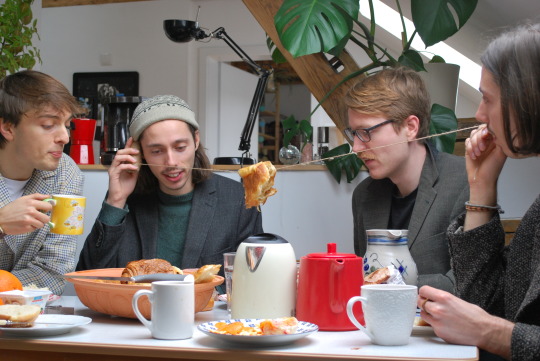
Long before the COVID-19 pandemic, our vivid everyday experiences and situated knowledges made us aware of the horrible failings of our current system of capital accumulation and neoliberal individualization. Now, as the pandemic ripped the glossy facial mask down from the face of our neoliberally organized societies with a virulent grin, these failings lay bare before our very eyes (the eye understood here as an interface between body and mind). Needless to say that our feeling of an urgent need to transform this failing neoliberal being-individually-outside-of-a-multispecies-world to a just and convivial being-together-in-a-multispecies-world currently seeks ways to burst out. Ironically, a virus, that our neoliberal societies interconnected through globalized capitalism helped to create, complicates a being-together-in-a-multispecies-world as of now.
This crisis nevertheless points towards a beyond, a speculative future, that will arise from our decisions we take now and from which new possibilites of being-in-the-world are going to emerge. We are right there, on the dancefloor, the space in-between past and future worlds. The way we dance will decide about the world we enter when departing from the dancefloor.
When the invitation came to play our first live concert at the Beyond Crisis Conference organized by the Free University of Bozen-Bolzano we did not hesitate to take this wonderful opportunity. Beyond Crisis. The beyond is our dancefloor. What a match! Still, we also wanted to participate in the sessions and workshops of the conference, so we recorded our concert beforehand and took part.
Luckily, we had the opportunity to participate in a workshop dedicated to the topic "Commoning, Subsistence & Sufficiency". Despite the fact that none of us were real 'experts' in these fields (Who even is an expert?), we had the feeling that commoning might be key for our future being-in-the-world. We had a great discussion with a handful of people via Zoom about what "commoning" can contribute to reaching social-ecological transformation and what the context of the current pandemic may implicate for this agenda.

We first identified three readings of the concept of "commoning": sufficiency, common land and data/common knowledge. Focusing primarily on the sufficiency-reading and the sense of community that this implicates, we characterised commoning as a need-oriented, communal living together of humans and non-humans based upon sharing and trusting relationships, no matter if it's about land, food, knowledge, health or other needs and resources. By not only sticking to human-human relations we quickly came to the point that "commoning" is actually a concept extracted from nature. It is important to keep this in mind and learn from the commoning practices of plants, animals and microbes as they themselves have commoning systems in place ensuring their survival. The biological understanding of diversity is key to this, as most ecosystems and their constituents rely on diversity in order to be resilient to phases of shortcomings, crises and catastrophes. We can observe that monocultural systems, let it be agricultural production or capital accumulation interweaving each other, are extremely vulnerable to crises as we can see in the increasing dependence on pesticides, insecticides, genetic modifications etc. in agriculture, as well as currently in the austerity-plagued health systems and non-existing economic safety nets of capitalist societies.
Diversity helps to reduce vulnerability and build up resilience. If one of many components is experiencing a crisis, others will step in and help out. An unconditional basic income would have helped to buffer the current economical crisis, as well as an alternative money system set up regionally to support local businesses. These are examples that already show on which scales resilient commoning systems can be established, mainly locally or regionally. While diversity helps building up resilience, it also needs to be a principle in re-organizing our power structures. A sole focus on building resilience obscures the power relations in which we are enmeshed. Therefore, we need to scale up the commoning concept in order to reduce the power of the financial sector, the agribusiness and the food industry.

If we want to scale up the commoning concept, we have to acknowledge its decentralised nature, promoting the diversity of many local projects and initiatives, e.g. urban gardening or farming projects working with permaculture, towns using alternative money systems (see “Bristol Pounds”), library of things, repair cafés/bike kitchen, alternative housing projects, RIVE/WWOOFing, alternative education models (scandinavian/multispecies etc.) or peer-to-peer insurances (e.g. Elinor-Network). A scaling up can only be achieved by entanglement. We need to interconnect the existing small scale commoning projects and make them visible as a big cloud of commoning. Being in a natureculture world characterized by entanglement and interconnectedness across all scales, we witness the implosion of scales. Our dominant framework of thinking with scales is not available anymore. Instead, we are urged to think in entanglements. We could start by paying attention to the human body and its symbiosis with trillions of microbes on the skin or in the gut. How about this commoning project?
Our relationship with food and beyond can be part of the solution, as we are feeding not only us as human beings, but trillions of microbes, that have specific needs we should take into account while choosing which food to eat. At the moment, due to the corona crisis, people maybe have more time to celebrate their daily meals and food is one of the last things available for us, at least in a rich country like Germany. This has the potential for our society to rethink our relationship with food and its importance for a good living, picturing a point of departure for a social-ecological transformation. For post-corona times food can be a lever to fulfill the desire for conviviality. Food is the ultimate community-builder as its production, distribution and processing involves people working together often resulting in the social event of eating together. However, the current way we produce, distribute and process food is highly unequal and unhealthy, so that we have to seek for alternatives.
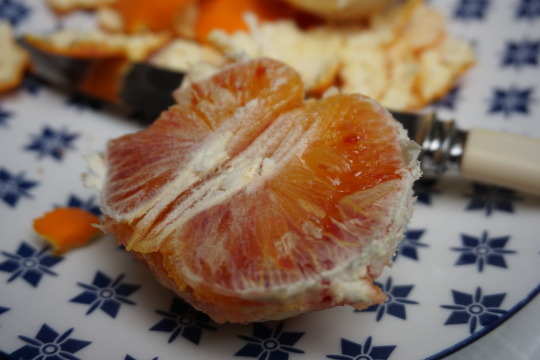
One outcome of the conference workshop was the idea of establishing community ovens especially in cities, as rural populations are more often used to sharing principles. This could even serve to transcend social bubbles by bringing people together that would otherwise never meet and encouraging them to share their distinct knowledge and skills with each other. The sour dough could be the facilitator, as it is a way of producing your own bread or pizza dough for every budget, even for homeless people. It can be shared and its special affordances discussed, even sensitising for our relations with the bacteria fermenting the sour dough leading to the end product of a piece of bread being shared among a community. Thus, it is only bottom-up practices that can enable the flourishing of the commons concept, letting people learn naturally to appreciate communities. And yes, even in times of social distancing having a community to rely on in crisis situations is crucial.
2 notes
·
View notes
Link
Shifting tectonic plates, not atmospheric carbon dioxide levels, controlled the strength of the powerful East Asian monsoon throughout its history, scientists say.
The monsoon is a seasonal system of winds that brings heavy rains to a vast swath of Asia, from India to Taiwan, each summer. The rains are a vitally important source of water for agriculture. Some previous research has suggested that past eras known to have had high atmospheric CO₂ levels and warmer temperatures might also have been times of fluctuating monsoon intensity. The implication that monsoons are far more sensitive to climate change than once thought is alarming in a warming world: Dramatic change in monsoon intensity in the near future would threaten food security for over a billion people.
Yet the new study offers some potentially good news on that front: Even during very warm periods in Earth’s past, such as the Eocene Epoch that lasted from 56 million to 34 million years ago, the monsoon’s intensity wasn’t much different than it is today.
Alexander Farnsworth, a paleoclimatologist at the University of Bristol in England, and colleagues combined plate tectonic reconstructions with paleotemperature “proxies” that provide clues to past climatic conditions. Such proxies, found in and near the Tibetan Plateau, include ancient fossils and pollen, as well as sedimentary deposits. Using these data, the team reconstructed the evolution of the monsoon going back 150 million years. What really exerted control over changes in the monsoon’s intensity were Earth’s slowly but constantly shifting landmasses, the team reports October 30 in Science Advances.

In China’s Yunnan Province, which includes part of the Tibetan Plateau, scientists collect sediment samples and leaf fossils dating to between 34 million and 23 million years ago. Such samples help reconstruct the ancient environment — and therefore, can reveal changes in monsoon intensity through time.
CREDIT: A. FARNSWORTH
The study also suggests that the monsoon is far older than once thought. “The traditional model is that the monsoon itself has only existed for the last 23 million years,” Farnsworth says. But new plant fossil data from the region have suggested that at least parts of the Tibetan Plateau were very wet much further back in time (SN: 3/11/19).Monsoon conditions existed as far back as the Early Cretaceous Period, about 136 million years ago, the study finds. But by 120 million years ago, the monsoon was gone, and for the rest of the Cretaceous, East Asia remained arid. Then, around 60 million years ago, the monsoon reappeared and began to intensify over the next 20 million years. It remained strong and stable until about 13 million years ago, when it kicked into high gear — a time that the scientists call the mid-Miocene “super-monsoon.” About 3.5 million years ago, it weakened again to an intensity similar to today’s.
That pattern, the researchers found, coincides with broad shifts in continental landmasses, which can alter atmospheric circulation patterns. For example, the westward movement of the Asian continent during the Late Cretaceous weakened the flow of trade winds from the Pacific, reducing the supply of moisture to the region. Then, the rise of the Himalayan-Tibetan region beginning around 50 million years ago began to block the flow of cold, dry air down from Asia; that allowed the warmer, moister air blowing north from the Indian Ocean to become dominant, intensifying the rains.
Other, even more distant, tectonic shifts may have played a role in the monsoon’s evolving strength, Farnsworth says, such as the uplift of the Iranian Plateau beginning sometime around 15 million years ago as the Arabian Plate collided with the Eurasian Plate. Determining how these other shifts impacted the monsoon will be the subject of ongoing work, he says.
Previous studies also have suggested that the East Asian monsoon has been around longer than once thought. For example, a 2012 study in the Journal of Asian Earth Sciences led by paleoclimatologist Matthew Huber of Purdue University in West Lafayette, Ind., simulated past climate conditions 40 million years ago. That study also found that monsoon conditions existed during the Eocene Epoch. However, Huber’s study linked those conditions to elevated atmospheric CO2 at the time.
But such a “time-slice” approach, which examines conditions during a small window of time, makes it difficult to see the how monsoon intensity varies against the big-picture backdrop of both geology and climate. “It’s robust and meaningful that they have these clear geologic signals through time,” says Huber, who was not involved in the new study. In that context, “the strong suggestion is that the monsoon in the region is much more impacted by changes in building mountain ranges than it is by changes in CO2.”
Farnsworth notes that there is no perfect past analog to present conditions. Even when the past climate resembled today’s, such as during the Eocene, the tectonic landscape was vastly different. “What this research shows is that we have to be cautious in how we interpret the past for what will happen in the future.”
And rising CO2 isn’t the only result of human activity, Farnsworth says. “There are all these other anthropogenic effects: land-use changes, aerosols.” Whether and how these factors affect the monsoon is still an open question.
9 notes
·
View notes
Photo

The Land Rover was conceived in 1947 by the Rover Company who before the war had produced luxury cars. In the aftermath of WW2 raw materials were strictly rationed to companies building construction and industrial equipment that could be exported to earn crucial foreign exchange for Britain. To get back on their feet Rover needed a resilient, basic vehicle with wide appeal - a workhorse for the world - that could be put into production quickly to generate income so they could return to what they knew best.
With their factory in Coventry bombed Rover were forced to move to a facility in Solihull previously used to build Bristol Hercules aircraft engines. Here, Rover's chief designer Maurice Wilks put into action his plan to produce a light agricultural utility vehicle, of a similar concept to the Willys Jeep, using his own experience of using an army-surplus Jeep on his farm in Anglesey, North Wales.
A cross between a light truck and a tractor, the Land-Rover used a sturdy box-section ladder chassis and repurposed the dependable engine and gearbox of a Rover P3 saloon. To save on steel, the bodywork was handmade from a lightweight corrosion resistant aluminium/magnesium alloy used in aircraft construction called Birmabright, and featured flat body panels and simple curves that could be easily formed on a basic jig. Door tops and a roof were optional extras.
The colour was dictated by military surplus light green aircraft paint found in the factory. The Land-Rover entered production in April 1948.
Rover were fighting for survival. What they built was an unstoppable winner.
#land rover#defender#resilience#jeep#green#necessity#ww2#innovation#british#creativity#resourceful#Aviation#wwII#landrover
2 notes
·
View notes
Text
Pasture For Life - My Quest
It seems a long time ago now since we changed all of our farming practices towards an organic future. The farm has changed, the life on it has improved dramatically, there is more wildlife, happier livestock and healthier soil. With so much discussion around greenhouse gases and climate change I think ruminant farmers do have a responsibility to ensure that their practices do not cause further harm to the environment, I at least want to make sure my operation is truly beneficial and that is why we are producing Pasture For Life meat.
It is certainly frustrating as a producer of the best beef in the world to have to continually listen to the mainstream media going on about eating less meat and turning vegan. I know there are a lot of people that believe it is not humane to eat meat and avoiding meat is best for sustainability and the planet but we need herbivores and that is the exact reason I farm and produce pasture for Life meat, building a case and solid reasons for people to choose mine over all factory-raised meat, that i certainly do not support.
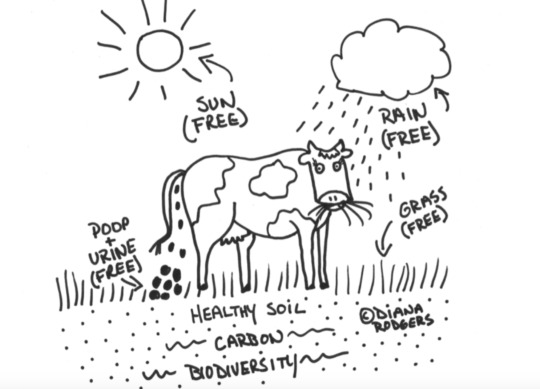
I certainly do not wish to be classed as the enemy in the battle against climate change, i am an environmentalist and I believe my animals at Herons Green Farm are carbon neutral, as the wonderful cartoon above demonstrates, grazing animals are beneficial for the soil, the work they do in carbon sequestration is amazing, "chewing the cud", as we say, stimulates new grass growth, the manure and urine they leave behind works microbes into the land, increasing the biodiversity of the life under the ground which helps in the process. We therefore store more carbon in the soil than our cows emit during their lives, the permanent pasture that makes up the farm and 70% of the nations farmland acts as a massive carbon sink.
At Herons Green Farm and The Communtiy Farm I have certainly seen a change in the soil diversity and its productivity since we have not routinely wormed our cattle or applied any artificial fertilisers since 2003. Agriculture is probably the most vulnerable industry to climate change, we are dictated by the weather, floods, droughts as our animals, environments and landscapes are too. However we are also in a unique position as we can correct it and sequester 50% or more of current greenhouse gas emissions in our soil. It is however not without its additional costs to the farmer and this obviously needs to be recognised and we need the consumers support for these farming systems that mitigate climate change and build residences to its impacts.
The Case for Eating Meat - There’s a Story behind everything we eat
So back to the argument of eating less meat and or turning vegan. I love the fact that extinction rebellion, XR are raising the bar on environmental issues that the governments have ignored for a generation. However the intensification of agriculture, the use of biofuels from cereals are all supported by big corporate finance, so is the vegan market, more plants, more agro-chemicals to grow them, more machinery, more for their shareholders. We have been reported to by the media with the wrong information, biased flawed science and so we have reached this juncture with millions of people reaching the wrong conclusions. It seems that if a point is presented as environmental then we are supposed to support it regardless of the consequences, a move to greater reliance on plant based protein for example will not benefit climate, ecology or human health and certainly not rural communities. As an organic farmer i believe we are offering solutions however we are being unfairly tainted with a brush that says a plant based diet is the answer? The disconnect with our population looking for environmental answers is huge. I want to stay open minded about the future, but people also need to investigate the truths more and look into the misrepresentations as regenerative farming cannot be pigeon holed along with other industrial led agriculture practices.
Is a vegan diet really more sustainable from a land use perspective. Most land is not suitable for vegetable production and therefore protein from animals is an important part of our diet and even more important from a land use perspective. It is a shame that other studies are not truly reflective of the meat industry as a whole, it mainly includes factory-raised meat in the figures which has a massive effect on the environment when you consider these cheaper factory produced animals are fed protein in the form of grain and soy that is imported from Brazilian rainforests and other countries. I found an interesting info-graphic which helps explain the environmental impact of pasture-fed beef.
http://rxprimal.com/2016/02/19/infograph-meat-and-the-earth/
For the first time, consumers have the knowledge to choose to, or choose not to, do their part in helping mitigate climate change. The production of these emissions can be reversed if people only eat regeneratively produced meat and vegetables. We have been doing it for it years but at last it has come to this juncture that we can ask our customers to buy more meat and vegetables from us and other producers that are farming in this way.
There is a snippet in the Guardian article which provides some common ground on which we can build: “
The large variability in environmental impact from different farms does present an opportunity for reducing the harm without needing the global population to become vegan”.
How 100% Pasture fed livestock is better for You
At the story you will be pleased to note that we have become members of the PFLA, Pasture Fed Livestock association because we believe that you will reap the benefits of meat that is reared in this way. The Health benefits of grass fed meat is huge not only to you but also the environment and the future of our food supply.
It is no secret or new thing but the emerging trend is that people are trying to source better meat and that usually means slowly reared and on grass fed diets. The new research proves that red meat reared on pasture based diets contains more omega 3, fatty and cancer properties.
The Story are giving you access to something very few people have as you can not only visit our farms to understand more about pasture fed livestock and what it means to how we rear our animals but you can also pick up some of the finest meat in the country at our butcher shop in Blagdon.
You will find that the meat far outweighs the grain fed non-organic mass produced meat that you can buy elsewhere. At Story butchers we ensure that our non-organic meat is also sourced from farms that do not feed grain as a substitute and because it is also hung for 30 days it easily gives you an unrivalled taste and tenderness.
Naturally we ensure our quality is maintained by using an Abbatoir that is close by at Langford, Bristol University because reducing the effect of stress on the animals during transit is paramount to the animals health and well being but also the end quality of the meat and hence taste. We ensure 28 days minimum of dry ageing process and hanging which enhances the meat further.
We want to help you help the environment by making that choice of eating more sustainable meat and feeling good about it at the same time. Look forward to seeing you soon!
1 note
·
View note
Text

Reynolds Metals Company International Headquarters
AKA Altria Headquarters 6601 West Broad Street Built, 1958 Architects, Gordon Bunshaft (building) of Skidmore, Owings & Merrill; Charles F. Gillette (landscape) VDHR 043-0242

January 1019
Richmond's showplace for aluminum.

(VDHR) — 1999 nomination photo
Conceived as the joint vision of company founder, Richard Samuel Reynolds, Sr. and the world's premier corporate architect, Gordon Bunshaft of Skidmore, Owings & Merrill, the headquarters is a monumental testament to architectural excellence. Classically elegant and subtly innovative, the International Style Executive Office Building is an archetype of suburban corporate headquarters: a medium-height office building in a park-like setting. The four-story courtyard building, like a palazzo, has a clearly defined base supporting the piano nobile, the upper stories, and the cornice. Architectural historian Richard Guy Wilson said of the headquarters that it "exemplifies the genius and promise of post World War II American modernism utilizing modern materials such as glass, steel, and especially aluminum, the Reynolds also makes use of time tested forms such as the palazzo type of format, and the courtyard".

(NCPedia) — R. J. Reynolds
The Reynolds family rose to prominence in the transitional period that gave birth to the New South. Sons of Hardin W. Reynolds, a prosperous farmer of Patrick County, Virginia, A. D. and R. J. Reynolds saw that the agricultural economy of their childhood must be supplanted by a more diverse and inventive model. Both brothers started tobacco companies, R. J. in Winston-Salem, North Carolina and A. D. in Bristol, Tennessee. Over the next decades, the tobacco industry emerged as one of the largest sectors of the nation's economy, principally through the creative marketing and packaging ideas practiced by companies like R. J. Reynolds Tobacco.
In 1903 while A. D. Reynolds' son Richard was a law student at the University of Virginia, his uncle R. J. induced him to apply his talents at the elder Reynolds' business in Winston-Salem. In the ten years he worked for his uncle, R. S. applied innovative ideas and marketing skills that elevated the company to a major force in the industry. With "Prince Albert in a Can" R. S. Reynolds introduced one of many industry-wide innovations, replacing cheesecloth bags with moisture-proof tin containers. Camel cigarettes were also introduced under the younger Reynolds' aegis, packaged in metal foil for freshness.
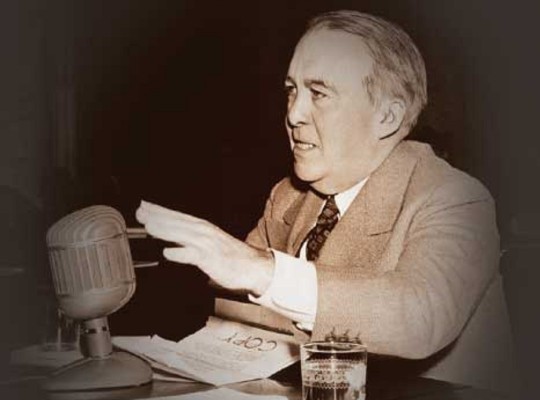
(Richard Reynolds Foundation) — R .S. Reynolds
R .S. Reynolds left the R. J. Reynolds Tobacco Company in 1913 and with his brothers founded a soap-making company in Bristol, Tennessee. As World War I came to a close R. S. Reynolds realized that there was a need for more and more specialized containers. When R. J. Reynolds Tobacco and British-American Tobacco faced a war-induced shortage of tin foil for cigarette packaging, Reynolds Corporation stepped in to produce lead and tin foils. In 1919 the three companies launched a partnership called the U.S. Foil Company, located in Louisville, Kentucky.

(Pinterest)
By 1924 the success of single-level assembly-line production methods enabled U.S. Foil to buy out its partners and also acquire its first subsidiary, the Eskimo Pie Company, which produced a frozen confection requiring metal foil packaging. With major clients dependant on foil production, Reynolds began to explore the possibilities of aluminum: it was lighter in weight than tin, and the yield per pound was greater. In 1926 U.S. Foil began production of aluminum foil. The next decade witnessed a great expansion of the company, now called Reynolds Metals, and more uses and greater facilities for production of aluminum were found.
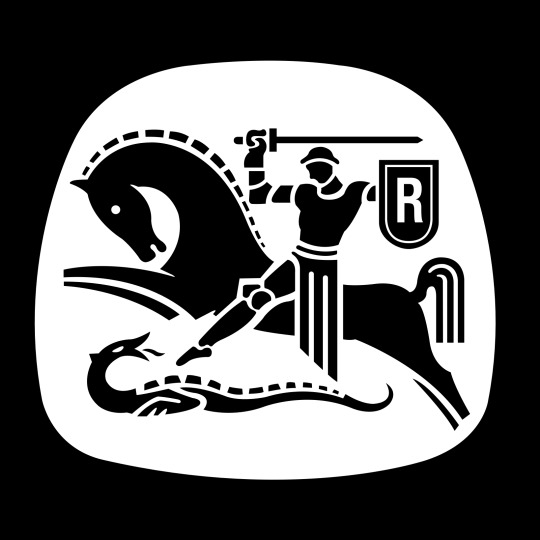
(World Vector Logo) — Reynolds Metals logo
Executive offices relocated to New York City, a foil-rolling plant was acquired in Richmond, Virginia, another plant opened in Havana, Cuba. Soon an array of new products entered the market: high-speed gravure-printed foil, aluminum bottle labels, heat-sealed foil bags for foods, and foil-laminated building insulation paper. Reynolds Metals did not wait for industries to seek out its packaging. Rather, the company developed products that fostered new industries and markets.

(Pinterest) — 1957 advertisement
In 1938 the executive offices of the company were moved to Richmond, Virginia, and the untiring company president, now assisted by his sons, continued the research into new uses for aluminum. It was due in large part to Reynolds Metals relocation to the city that Richmond enjoyed relative prosperity and an increasing volume of industrial sales during the late 1930s. Reynolds employees worked in three continuous shifts to meet wartime demand in the early 1940s. In 1947 Richmond became the first test market for Reynold's Wrap, which was introduced to local housewives by Reynolds saleswomen stationed in Miller & Rhoads' lingerie department. A subsequent string of aluminum automotive, packaging and building products transformed modem life. As buildings used more aluminum components, the savings of transporting this light weight, energy efficient material made more resources available for other enterprise.
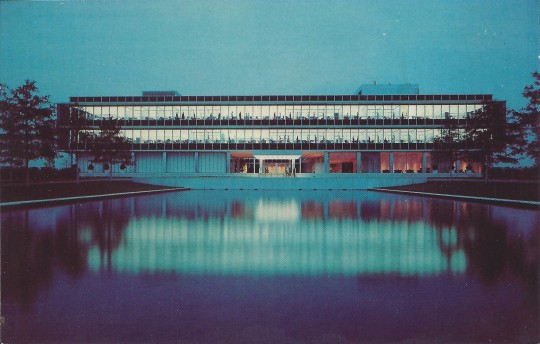
(Rocket Werks RVA Postcards) — showing entrance canopy at center
Richard S. Reynolds, Jr. succeeded his father as president of Reynolds Metals in 1948, continuing the exploration of new uses for aluminum, and the expansion of production here and abroad. It was during his stewardship that the 300,000 square-foot headquarters building was built, showcasing aluminum as a building material. Richard S. Reynolds, Jr. welcomed employees to the new company headquarters with a brochure that described the comforts of the building's air-conditioning, its sun-louvers, and perpetual "Music by Muzak" in glowing terms. The glass-and-aluminum curtain walls of the Executive Office Building represented state-of-the-art design: the use of aluminum was transforming building practices in ways exemplified in the new building. The cantilevered aluminum entrance canopy pushed the limits of the metal's structural capacities. Aluminum threads in carpets and draperies heralded new possibilities. These advances in the building industry were no overnight occurrence but had been signaled earlier with aluminum-backed building papers and in 1945 when Reynolds introduced aluminum siding.
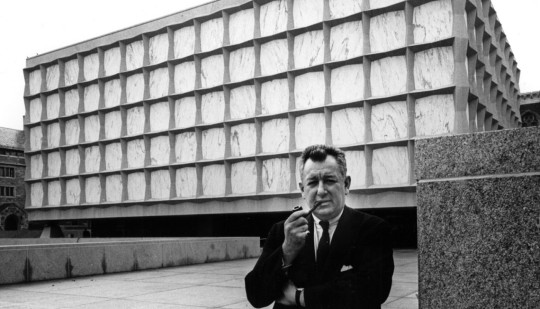
(Medium) — George Bunshaft
Architect Gordon Bunshaft attended the Massachusetts Institute of Technology and was recruited to join Skidmore, Owings & Merrill in 1937. Bunshaft's genius lay in an aesthetic reductivism. He could pare a building's elements to refined elegance. This propensity is embodied in the Reynolds' headquarters and at the landmark Philip Moms Cigarette Manufacturing Plant just south of Richmond.
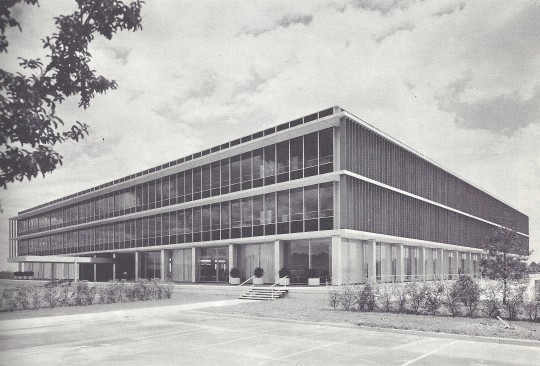
[COC]
Like Bunshaft's earlier masterpiece, Lever House in New York, the Executive Office Building hovers above its podium on slender columns and with a ground level loggia connects interior and exterior spaces. The Reynolds headquarters building is a cube with an off-center peristyle courtyard surrounded by aluminum-clad columns. On the east and west elevations enormous, bright blue, vertical louvers filter the sun. On the north and south, the building's horizontality is asserted by broad overhangs at each floor. The glass curtain wall is articulated with narrow aluminum mullions. The entire building sits on a podium that, at its south side, opens a full story below the main entry level to a generous ground-level terrace for the employees' cafeteria.
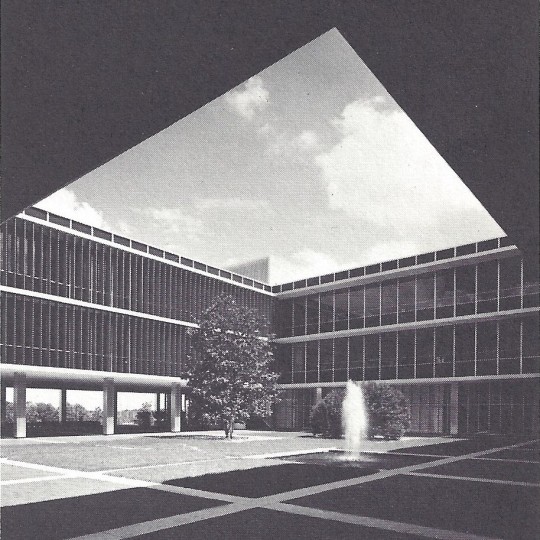
[COC]
On the north side, the forecourt leads to a centered canopy whose cantilevered projection announces entry. From a covered loggia, one enters either the auditorium, the lobby, or the courtyard. On the left, inside the freestanding auditorium is a curving, sawtooth, aluminum ceiling. Opposite, the red brick walk, laid in running bond, continues into the interior of the long glass-fronted lobby. A long suite of executive offices and the board room extend across the south side of the ground floor. Extruded aluminum forms the window frames, the linear diffusers, the column cladding, and even provides the base for glazed bathroom tile. Improbable combinations of aluminum, cherry panels, brick, plastic laminate, and striated black and white book-matched marble create an interior of undeniable elegance and sophistication.

(Richmond Times-Dispatch) — Ms. Ethel Bule and Ms. Bonnie Foy at new Reynold Metal's office building — June 25, 1958
The design and construction of the Executive Office Building intentionally demonstrate the multiple uses for aluminum in the building industry. The total weight of aluminum products found throughout the structure is 1,235,800 pounds. The largest single amount, almost 400,000 pounds is found in the cladding of the major exterior architectural elements. Even carpets and draperies were woven with aluminum fibers. Among the most innovative features of the building me the fourteen-foot-high solar louvers on the east and west sides of the building, which shifts, based on the calculations of an astronomical clock, throughout the day.
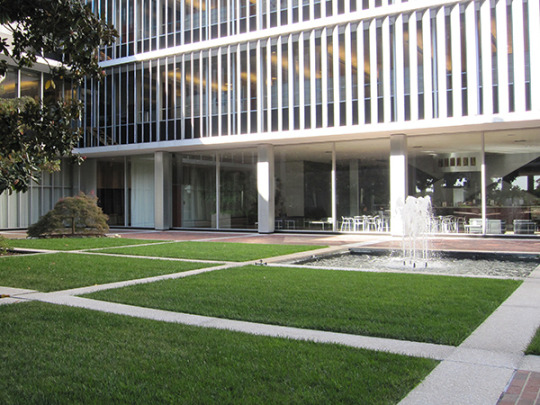
(The Cultural Landscape Foundation) — showing window louvers
On overcast days, an electric eye overrides the clock and the louvers stay open to allow maximum natural light. In 1958 this installation of solar louvers was the largest in the world. The building's interior partitions and openings were modular so that changes in the size or function of a space might be easily accommodated. SOM designed or specified virtually all of the original finishes and furnishings, many of which remain in the building. Original furniture included now classic desks, casework, and chairs designed by such eminent designers as Florence Knoll, Eero Saarinen, and Hans Wegner.
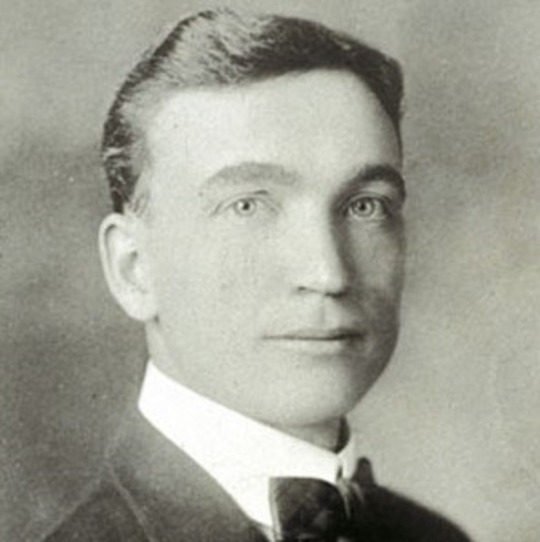
(The Cultural Landscape Foundation) — Charles F. Gillette
Charles F. Gillette, Richmond's preeminent landscape architect was retained as consultant to select plantings for the new headquarters' grounds. Gillette was in his late 60's when he accepted the contract to design the landscaped setting of Gordon Bunshaft's Reynolds Metals headquarters building. His budget for the project's landscape materials ($130,000) was the largest budget Gillette had ever worked with. Even with this largesse, the scale of the project was so huge that Gillette was forced to reduce the size of the plant materials so that the budget would not be exceeded and his concepts could be realized.
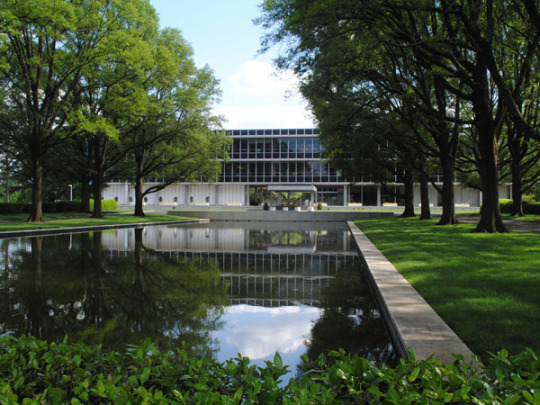
(The Cultural Landscape Foundation)
The Reynolds site plantings are used variously to screen parking, to control and frame views to the headquarters building, to create a formal entry, to enhance the courtyard, and to provide a landscaped park at the building's south side. The most dramatic landscape feature is the 250-foot long reflecting pool flanked by willow oaks. The reflecting pool continues to supply the water for the sprinkler system that waters the primary grounds. Within the building's courtyard Gillette specified and selected a forty-foot tall magnolia tree, the largest transplant ever achieved at that time. A water fountain fills another square within this gridded parterre.

(The Cultural Landscape Foundation)
Gillette's placement of plant materials and landscape features within the grid, an articulation of the building's structural bays, was deliberately asymmetrical yet perfectly balanced. Hedges of sculpted yaupon hollies screen the symmetrically disposed employee parking. The uninterrupted hedges also delay a full view of the headquarters building until the visitor arrives at the formal forecourt. Along West Broad Street grouped plantings in a broad meadow frame glimpses of the building. Although the raised courtyard is the focal point of the building's main level, smaller perimeter plantings of holly and other shrubs fit within the podium's ordered grid. Rectangular pools, once planted with lilies, enhance a relatively secluded terrace outside the suite of senior executive offices.
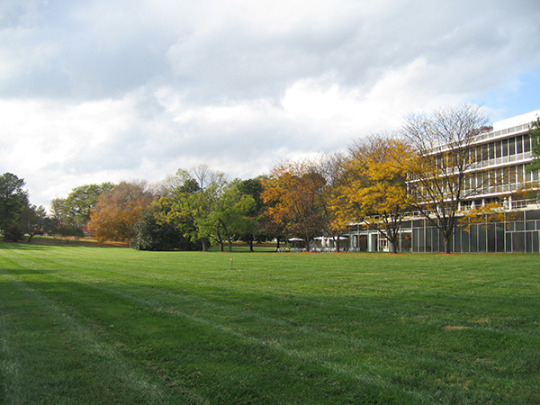
(The Cultural Landscape Foundation)
At the rear of the site, the South Lawn, a once-lush garden included flowering shrubs and weeping willows. Gillette unsuccessfully argued for placement of a pond in this low, moist area, which would have been a lovely foil for the reflecting pond at the other side of the property. The owner and architect imposed other undoubtedly frustrating constraints on Gillette, yet his landscape design for the Reynolds headquarters won the annual American Association of Nurserymen's Industrial Landscaping Competition in 1959.

(Period Paper) — 1950 advertisement
The first decades following relocation to the West Broad Street headquarters coincided with the period of Reynolds Metals' greatest expansion. "It was a very exciting time for the company. Reynolds was the leader in the industry during this period," recalled Gilbert R. Shockley, general director of Product Development in the 1960s and early 1970s. Different roofing materials were developed for farm, industry, and residential use. A variety of aluminum-combination panels had decorative as well as structural applications. Heavy-duty aluminum pipe began to be used for drilling oil.
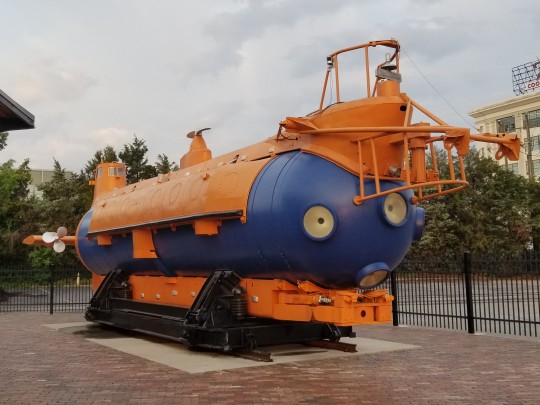
May 2018 — The Aluminaut in its current location at the Science Museum of Virginia
The Aluminaut, the world's first aluminum submarine, the deepest diving submarine of its time, was launched in 1964. In collaboration with the armed services, river hovercraft were developed in the 1960s and 1970s. In 1970 Reynolds and General Motors collaborated to produce the first all-aluminum engine, a technology today used by Porsche. By the time Richard Reynolds, Jr. became CEO and chairman of the board in 1963, company assets totaled over $1 billion. Joseph H. McConnell was the company president and chief administrative officer. (VDHR)

January 2019
But the good times did not last. Reynolds’ Metals was acquired by Alcoa in 2000, and the 35-acre former headquarters campus and buildings were picked up by the University of Richmond in 2001 for a mere $8 million. It was in turn leased to Philip Morris USA in 2003 and later joined by parent company Altria in 2008. Altria then purchased the whole kit and kaboodle outright in 2017 for $20.8 million. (Richmond Times-Dispatch)
Sadly, while Altria is being a great steward to this historic property, it’s hard to see very much of it, protected as it is behind gated fences. It’s understandable that Altria wants to protect its corporate privacy, but one wishes there was a way to make some part of this hidden gem available to the public view.
(Reynolds Metals Company International Headquarters is part of the Atlas RVA! Project)
Sources
[COC] A Century of Commerce, 1867-1967. James K. Sanford. 1967.
5 notes
·
View notes
Photo

Today the @nrmbristolaggie juniors had a class on building professional posters with our technology & librarian. This is such an important professional skill to develop and invaluable to do so before undergraduate study. I hope to see these students present is a conference poster session someday soon. Thank you Ms. Moriarty, Mr. Costa and Mrs. Noel. #bristolaggienrm #posterpresentation #professionalskills #technology #undergrad #conference #classof2020 #students #mystudentrock (at Bristol County Agricultural High) https://www.instagram.com/p/BufSFZ-ndOH/?utm_source=ig_tumblr_share&igshid=1ebrnas402bqd
#bristolaggienrm#posterpresentation#professionalskills#technology#undergrad#conference#classof2020#students#mystudentrock
3 notes
·
View notes
Text
Research Into Photographers
Matt Black

Matt Black is from California’s Central Valley, an agricultural region in the heart of the state. His work has explored the connections between migration, poverty, agriculture, and the environment in his native rural California and in southern Mexico. He has traveled over 100,000 miles across 46 U.S. states for his project The Geography of Poverty. So he is documenting poverty across the world. It was taken in Alpaugh, Calif. Alpaugh is a town in Tulare County, California. The population is 1,026 and 55.4 percent live below the poverty level. Out of all the places he photographed, this place has the largest percentage of people who live below the poverty level. I really like this image as it is a shot of a girl in a building/house, the fact you can only really see her outline and her body and face has a shadow covering it. Which I think makes it look more effective as it could show that she is in darkness or is alone because of the awful situation she is in. I think the way he took this shot is really impressive as it really helps the observer attach emotions to the girl as we would feel sorry for her or sympathy towards her.
Sonja Hamad

These are her words to describe this project, “Jin - Jiyan - Azadi: Women, Life, Freedom” provides us with a powerful, unique look into the all-female fighting units in Kurdistan. Being born in Syria and having Kurdish parents, you must have felt a strong connection to the women you documented. What was it like for you, on a personal level, to spend time with these fighters? What did you learn from them?” I really like this shot as it shows female empowerment, how if women unite, we can work together to achieve something that is so powerful and important. I love the fact that it’s as if they are looking over something (the hill) which could symbolize inequality and how we should all treat each other with respect in order to make this world a better place.
Mustafah Abdulaziz

lassic Club Golf Course. Palm Desert, California, USA, 2015. 1986, New York City, USA. Lives in Berlin, Germany. His on-going project Water has received support from the United Nations, WaterAid, WWF, VSCO, and Google, has been reviewed by Phaidon, Monopol and published in Der Spiegel, The New Yorker, TIME and The Guardian. Worked as the first contract photographer for The Wall Street Journal. In 2012, was named one of PDN’s 30 Emerging Photographers to Watch. His work has been exhibited at Strandvägen in Stockholm, The Scoop in London, Brooklyn Waterfront in New York City, König Galerie in Berlin and the National Geographic Museum in Washington D.C. He is documenting water shortage. I like this photo as it is composed really well, with the contrast between the bare, dry land and the deep green and blue of the water and greenary. The way it has been taken I think looks really effective as it is almost a birds eye view shot and really shows the difference between the dry land and the section that could be compared to the life of the photo.
Corey Arnold

Corey Arnold is a photographer and commercial fisherman by trade. He has worked seasonally as a commercial fisherman in Alaska since 1995, including seven years of crabbing in the Bering Sea aboard the f/v Rollo. Corey now captains a commercial gillnetter, harvesting wild and sustainable Sockeye salmon in Bristol Bay, Alaska while living seasonally in an abandoned salmon cannery complex called Graveyard Point. His life’s work: Fish-Work is an ongoing photography series documenting the viceral experience of life at sea for commercial fishermen worldwide. Here is documenting ‘life at sea’, he has photographed an ‘action shot’ of a boat, with fishing gear and and people working on the boat. I really like this image, as the background is quite dull colours, blue, grey and white. Then there are splashes of neon colour, coming from the boyes and the workers, and looks really effective as they contrast well. I also like that it is an action shot, so you can see the crashing of the waves and the seagulls flying around it.
James Mollison

James Mollison was born in Kenya in 1973 and grew up in England. After studying Art and Design at Oxford Brookes University, and later film and photography at Newport School of Art and Design, he moved to Italy to work at Benetton’s creative lab, Fabrica. His fourth book Where Children Sleep was published in November 2010- stories of diverse children around the world, told through portraits and pictures of their bedroom. I like his style of photograph for this project, as he is showing where each child lives, by photographing a portrait of the child then a photo of their bedroom. I like the fact that he has shown both so we can sort of understand who lives their and feel an emotional connection towards them. For this specific one, it makes me feel sad and sympathy towards her as her sleeping situation is not that nice or clean.
Toy Stories

Gabriele Galimberti, born in 1977, is an Italian photographer who frequently lives on airplanes, and occasionally in Val di Chiana (Tuscany), where he was born and raised. He has spent the last few years working on long-term documentary photography projects around the world, some of which have become books, such as Toy Stories, In Her Kitchen, My Couch Is Your Couch and The Heavens. Gabriele’s job consists mainly of telling the stories, through portraits and short stories, of people around the world, recounting their peculiarities and differences, the things they are proud of and the belongings with which they surround themselves; social media, in all its forms, is a fundamental part of the research needed to get in touch, discover and produce those stories.
I think that this photo is trying to show the boys’ interest in dinosaurs, and could represent that his life is based around this hobby. I think it looks effective that he is stood on his bed but the toys are surrounding him, I also like the bright colours that are incorporated in the shot.
Fan Ho

Born in Shanghai in 1931, an award-winning photographer, won over 300 awards. This image is taken from the ‘a hong kong memoir’ collection, it was taken during 1950′s-60′s and printed during 1950′s-70′s. During this time Fan Ho was a one man working studio. He would photograph late afternoon, process and print his film at night, and do it all over the next day. Giving a sense of history, some of the images awards stamped on the back from competitions he entered.
I like this image because the black and white looks really effective as the levels of depth of colour look really good and I also like that the light shining through the windows, and how bright it is , and that it contrasts with the deep black.
Richard Billingham

Richard Billingham’s “Ray’s a Laugh”, published in 2000 by Scalo, is a bone jarring chronicle of the parts of life that shouldn’t… the life that tried, but wouldn’t, and dreams that simply couldn’t.
I like his work, as he is just photographing his life, and what is surrounding him, I like the way he photographs as it is quite unusual the angles and what he chooses to photograph. I also like the fact he shoots in colour, as some of the most basic colours are really popping as the backgrounds are quite dull. But it tends to be their skin that is mainly catching your eye in the photos as the light is bouncing off it and making it stand out. I also like how it is such a basic idea yet looks so effective.
Jim Goldberg

The photographs in this book constitute a shocking and gripping portrait of contemporary America. Jim Goldberg's photographs of rich and poor people, with the subjects' own handwritten comments about themselves on the prints, give us an inside look at the American dream at both ends of the social scale.His pictures reveal his subjects' innermost fears and aspirations, their perceptions and illusions about themselves, with a frankness that makes the portraits as engrossing as they are disturbing.
I chose this image, as I think it gives off a powerful message, he is trying to portray the way that people feel and what they go through day to day. I think his book of photographs is very effective the way he shoots his photographs. I also really like the fact he has included quotes from what people have said, as this really adds an emotional touch to the photos, it makes us as viewers really understand what the message is and the context of the photographs.
Rich and Poor - Jim Goldberg

This is another example of Jim Goldbergs’ work, which shows the elements of rich and poor. The photographs in this book constitute a shocking and gripping portrait of contemporary America. Jim Goldberg's photographs of rich and poor people, with the subjects' own handwritten comments about themselves on the prints, give us an inside look at the American dream at both ends of the social scale.His pictures reveal his subjects' innermost fears and aspirations, their perceptions and illusions about themselves, with a frankness that makes the portraits as engrossing as they are disturbing.
This photograph was taken by Jim Goldberg, it is of a family that is probably quite poor as they are struggling for basic necessities such as clothes. This photograph was taken in 1979, in San Francisco. I think this photo is very effective as it shows a deep meaning behind quite a simple shot. I really like this shot as it is black and white so looks good with the shadows.
1 note
·
View note
Link
0 notes
Text
The Travellers, Vol 5, Pt 5: The Interwar Years
Having survived the First World War, the members of the team could breathe a collective sigh of relief. They were none too concerned about the Spanish Flu. Many of their children who now constituted “generation one” had begun to come of age just as the war was ending. They had all attended good schools where they had excelled academically, as well as in their sporting and extracurricular endeavours, and they now started to head off to university.
[[MORE]]
Generation one would face much the same dilemma as generation zero. They would mostly be in their mid to late thirties by the time the Second World War broke out and would be expected to do their duty. However, none of them would be the type of person who might be liable to be sacrificed in the path of German tanks or aircraft.
For example, Edward Nolan and Thomas Wilde, the older sons of Arthur Nolan and David Wilde, would take over the family business in the early 1930s. Their fathers would be called back out of retirement during the war to run the business again but only because their sons had important consulting positions as officers within the RAF engineering corps. William Nolan, Edward’s younger brother, was a noted scientist with a specialisation in atomic physics. He spent the war working for the Department of Scientific and Industrial Research. As did Oliver Wilde, Thomas’ younger brother, who was a bit of an expert in things like radio detection.
Naturally, Rover, the Bristol Aeroplane Company, and Mercury Electrical Industries would once again be vital to the war effort and there was no question that anyone in charge of running those companies, or performing a critical role in the product development process, would be conscripted.
A couple of new variant ventures emerged during the interwar years, too. The team had been investors in the British Tabulating Machine Company for several years before buying them out in 1919. The leading figures in the takeover bid were two former army surgeons by the names of Joseph Bell and Nicholas Burroughs. Their eldest sons were both studying mathematics at Cambridge, and they had some ideas concerning the potential capabilities of these tabulating machines. They renamed the company “Advanced Tabulating Machines”, or “ATM” for short, as it was less parochial. They then started building machines to their own original designs, rather than simply importing or reconstructing American “Hollerith” tabulators.
Their other new interest was based in East Anglia and was being led by a gentleman called Charles Lockwood in partnership with another local variant by the name of Philip Hunter. Charles had purchased Little Massingham Manor in 1916 and the pair of them owned a few farms in Norfolk and Cambridgeshire. During the 1920s, they began to expand their interests, becoming involved in the development of organic fertilisers, new crop strains, and improved livestock feeds, which eventually led to the establishment of an agribusiness called Lockwood & Hunter that commercialised the results of their research.
Lockwood & Hunter were quite different from some other concerns that were working at the forefront of agricultural science. They had a rather unfashionable interest in sustainability and traditional farming practices, often arguing that these could be significantly improved in ways that would provide sufficient yields over a longer term without resorting to what their owners regarded as environmentally and socially damaging techniques. By no means were they always listened to, but they had supporters. Most of whom were fascists.
Mercury grew rapidly following the war as the age of the wireless exploded onto the scene. They made some lovely sets under their “Audiophile” badge that became known for the quality of their sound reproduction. They were also making some amazing “Apollo” cameras. Their sound engineers travelled the globe recording artists of all kinds and genres, both famous and obscure, for their associated record label.
Rover-Triumph also went from strength to strength as motorised transport continued to spread. Triumph entered cars into the emerging racing scene and enjoyed a good deal of success while, powered by their engines, Rover focused on the burgeoning mass market in passenger, commercial, and agricultural vehicles.
The Bristol Aeroplane Company likewise continued their steady progress, keeping pace with developments in the industry elsewhere while setting some landmark firsts and breaking a few records in the process. They had snaffled £10,000 with John Alcock and Arthur Brown in 1918 after the BAC team successfully flew a specially adapted “Type 3” non-stop from Newfoundland to Galway, a distance of over 1,900 miles. However, since it was announced in 1919, the Orteig Prize had upped the ante for the first team to successfully complete a non-stop transatlantic flight over the much greater distance of over 3,500 miles between New York and Paris.
By 1924, BAC had developed the Bristol Type 14 “Belle”. In many respects, it was a Cessna 172 with a Cessna 350-style aerodynamic fuselage constructed from UNS 6061-O aluminium-titanium alloy with a basic 6-instrument panel (revolutionary at the time). It was tricked out with additional fuel tanks, notably on the wing tips, to extend its range, and a retractable landing gear to reduce drag. It was powered by a standard supercharged 4-stroke piston engine that took high-octane aviation fuel to power its single propeller. BAC would go on to sell many units of a less pimped out version over the years. However, for now, it was still a prototype.
In 1925, Edward Fairchild and Maurice Falconer approached Amelia Earhart and Bessie Coleman to be their pilots. At the end of August 1926, after over a solid year of training and preparation, they took off from New York. It was a very dry month with weak Atlantic fronts and only light rainfall. Earhart and Coleman landed in Paris just under 30 hours later to win the prize to rapturous acclaim and jubilation. Both pilots became overnight sensations, and each would go on to achieve many more feats of aviation. Fairchild and Falconer subsequently established subsidised gliding clubs all over the country and opened a free flying school at Filton at which any British imperial subject could gain a pilot’s licence.
Rover, BAC, and Mercury all expanded and established manufacturing facilities abroad, most notably in the US. In America, BAC set up shop appropriately enough in Bristol PA after acquiring Keystone Aircraft. Rover based themselves in Cleveland. Mercury focused on New Haven, giving them a convenient position close to Yale and between Harvard and Columbia in Boston and New York. In each case, they adjusted their branding and image to present themselves as “all American” firms.
The variants were not operating from an all-powerful position where they could control everything, so a lot of things went against them and, as in MOT, trends emerged that they personally wouldn’t have chosen. The price of oil dropped dramatically, and its associated infrastructure grew rapidly. This fuelled the rise of the internal combustion engine and sales of Rover’s battery powered models declined, becoming something of a niche area for the company. Similarly, all their firms faced significant challenges as postwar global economic conditions led to a rise in protectionist policies. However, they did have some notable victories they were proud of.
Controversy erupted in 1924 as the serious negative health impacts of tetraethyl lead on refinery workers was revealed. The development of the use of TEL as an antiknock agent had been a joint effort between DuPont, Standard Oil, and General Motors. Amoco were pushing the use of ethanol for this purpose. However, while it is far less poisonous, ethanol is not as effective an agent as tetraethyllead and carries significant corrosive potential that needs to be factored into engine design and construction. Amoco funded an astroturf campaign against tetraethyllead and pursued DuPont and their partners through the US legal and political system over the course of the 1920s. Fortunately, a rather excellent young chemist at Yale by the name of John Martin discovered something called ferrocene, for which he won a Nobel Prize in chemistry. Their campaign subsequently managed to get TEL banned almost everywhere by the 1930s.
They were funding a similar campaign against asbestos, the health hazards of which had begun to be noted shortly after their arrival. John Martin was again involved in the development of safer alternative materials. Although success in this area took a little longer to achieve, they would eventually win after the Second World War.
Other than all of that, while they were all working very hard, they were also enjoying themselves. Despite the pressures faced by some of their businesses during the depression, the personal wealth of the individual team members was effectively assured. Aside from the fresh injections of capital they received from the future on the diagonal when they substituted their offspring or data jumps arrived, they had plenty of money to share around between them and were more than capable of subtly playing the markets, or even gambling, to obtain a plentiful supply of ready cash. On top of that, Hawkins and Grey had set up a prospecting company called North Star that had a great deal of success, finding oil, gas, gold, silver, diamonds, and a host of other precious resources in Africa, North America, and Australasia.
They purchased nice country pads for themselves, acquired works by emerging artists and old masters, and travelled the world in luxury. The Delaneys, who acquired Litley Court, demolished the decidedly average early Victorian house and had a far better Arts & Crafts style mansion built in its place by Edwin Lutyens. The Moore, Nolan, and Wilde families had all also relocated to Herefordshire, which was down the railway line from Longbridge, and the team began to take an active interest in the development of the county through public works, commercial developments, investments, and housing projects. The Chadwick family, another scion of the team, were also in the county, having been the ones to acquire Brinsop Court this time around.
Many among the older generation of variants handed over control of their business concerns to their children and retired to these estates where they often did things like take up a bit of farming. They even published some cookery books and self-sufficiency guides. Eventually however, after 15 years of messing around, the storm clouds began to form over Europe. The salad days were over.
0 notes
Text
How to Avoid Blocked Silos in Food Production
It is not easy keeping your storage silo in check. To get the most out of your food production silo, you need to ensure there are no blockages. The good news is with some routine maintenance, correct unloading and more, you can reduce the risk of blockages, ensuring your food production remains productive.
The first step to avoiding a blocked silo in food production is regular maintenance. Regular maintenance is essential to reducing the risk of blockage build ups. Maintenance also ensures that your silo is in the best condition, ready for the next load without worrying about potential problems. Prevention is always better than cure and maintenance is a preventative measure, identifying problems before they cause an expensive break down.

Next is to ensure the silo is unloaded correctly, Incorrect unloading can often cause blockages. It is essential that the dispersal is aligned to the exit, if not then you can expect food to block the exit points, which will slow production and can cause unnecessary delays as you work to remove the blockage.
Its essential to ensure you keep the exit of the silo clear. To avoid blockages the path to the exit should always be clear. A poorly designed exit or a blocked path can cause problems later on, including unwelcome blockages.
Bridging inside the silo happens with water absorbing food products, such as sugar, for example. When the food mixes with water, it bonds and hardens, which has a negative impact on the operation of the silo. Bridging can hamper powder flow. It can be very risky to remove bridging, which requires breaking it up and manually removing it. The answer is to ensure the bulk storage silos you purchase are contamination free and are able to store the food in a dry manner to reduce the risk of bridging moving forward.
If you experience regular blockages in your food silo, then you may want to look into a flow of the products that are being stored. Keeping the food in constant motion can reduce the risk of bridging. This is a good solution for those that experience frequent silo blockages in food production.
Silo storage is not an easy job, but with some knowledge and regular maintenance, you can avoid blockages, which slows production. Use a reputable silo specialist that has the knowledge and experience to service and repair your food silo with confidence. Silos are used to store bulk materials, usually in the agricultural industry. They are often used to store grain, wheat and fermented feed, also known as silage.
In addition to this, silos are used to store wood chips, food products, cement and coal. All of which can be easily damaged and cause blockages if they are exposed to external elements, such as dampness and water. Silos are an essential part of farming, offering safe storage of wheat and high moisture grains.
The primary function of the silo is to isolate and protect the food product, extending its storage life. Unloaders are used when removing the food from the silo, which must be done within a certain period and taking care not to cause blockages.
With advancements in technology and manufacturing, there are a range of bulk storage silo options to choose from. Always discuss blockage possibilities with the supplier before making decisions. Reputable companies will custom design, manufacture and install the silo based on how you intend using it. They will ensure that the exit is well designed and give you information and assistance on how to use the silo and how to avoid blockages in the future.
About Us: Barton Fabrications is the leading design, manufacturing, installation and servicing of aluminium and stainless steel bulk storage silos in the United Kingdom. This well established company, based in Bristol, brings more than forty years of experience to the plate, specialising in technical silos and pressure vessels. The company caters to food manufacturers, plastic recyclers, packaging companies, pharmaceutical and chemical companies, to name a few. Barton fabrications has installed more than one thousand silos throughout the world and are fully legislation compliant. Full details can be found at https://www.bartonfabs.co.uk.
0 notes
Text
4 Vital Benefits that an Agricultural Building offers to a Farmer
The importance of the agricultural field is known to humankind. However, with the growing population, the need to preserve it in an efficient manner has significantly increased more than ever before. This had lead to many changes in the field of agriculture and one of them being agricultural buildings in Worcester. These buildings are packed with many benefits and have been helping farmers in multiples ways worldwide. This is the reason why they are so popular in Hereford.
The residents in Birmingham use agricultural buildings as storage facilities too, and this way they protect the expensive farm equipment from harsh climatic conditions. Also, since they are available in all forms and sizes you can buy one according to your requirements. Below written are a few ways, how agricultural buildings are beneficial in Manchester:
Customise
The need of every farmer is different from each other with specific requirements for the barn. Agricultural buildings can be customized according to needs and hence is taking over the market in Bristol. The structure of a pig farm is different than a chicken and agriculture farm buildings can be adjusted accordingly without much effort.
Read More Original Content at agricultural buildings in Bristol
#agricultural buildings#agricultural buildings in Worcester#agricultural buildings in Bristol#Manchester#Birmingham#Hereford#Oxford#Leicester
0 notes
Text
Fwd: Graduate position: BristolU.HumanImpactOnBees
Begin forwarded message: > From: [email protected] > Subject: Graduate position: BristolU.HumanImpactOnBees > Date: 30 October 2021 at 08:11:44 BST > To: [email protected] > > > > > We invite applications for a PhD opportunity to study the links > between human impacts and thebehaviour & ecology of bees in the UK > and the Brazilian Amazon region. The project is jointly supervised > by Dr Christoph Grueter and Dr Emily Bell, University of Bristol, > in collaboration with not-for-profit organisation Meli Bees > (https://ift.tt/3nAYwx2). > > For informal enquiries, contact Christoph Grueter: [email protected] > > Project Background > > Bees are important pollinators of agricultural and wild plants, yet they > also face many challenges, including habitat loss, pesticides, diseases, > and poor nutrition. Among the most important pollinators in temperate > regions are honeybees (Apis mellifera) and, in the tropics, the stingless > bees (Meliponini). People keep bees in apiaries to facilitate beekeeping > and pollination. For traditional communities in the Amazon, beekeeping > of native Brazilian stingless bees is of both economic and cultural > importance as bees provide food, income, and medicinal products. However, > keeping bees in apiaries in highly disturbed environments is challenging > as bees might struggle to find enough food, leading to poor health of > colonies. Furthermore, the proximity of hives in an apiary promotes > “drifting”, which means that bees enter the wrong hive and leads to > disease spread and lowers the honey and pollen production of colonies. > > Project Aims and Methods > > This project brings together an exciting mix of methodological approaches > to study how “drifting” in stingless bees in Brazil and in honeybees > in the UK is related to their foraging landscape. The project will study > drifting in environments varying in human disturbance, particularly > different degrees of deforestation and urbanisation. The main aims are > (1) to identify the key food sources for bees in modified and natural > environments; (2) to investigate if food source availability and diversity > affects drifting behaviour; (3) to test whether entrance guarding by > guard bees can prevent drifting and (4) whether artificial landmarks in > apiaries can reduce drifting behaviour. Results will help us identify > the most important food sources for these important pollinators and help > improve the health and productivity of bees. > > The project will study stingless bee hives kept by traditional communities > in the Maranhão state in the Brazilian Amazon region, which has been > heavily affected by deforestation and in honeybee hives inhabiting > different landscapes in the South West of England. Pollen quantity and > diversity will be assessed using DNA metabarcoding, while drifting is > studied using Radio-frequency identification (RFID) tracking of bees and > behavioural observations. In addition to these aims, the project provides > opportunities for the candidate to build on or modify the project and > develop their own research ideas within the general research topic. > > Candidate requirements > > We seek a highly motivated, dedicated, and collaborative student > with an interest in behaviour, ecology, and entomology. You should be > eager to learn about the natural history of bees, molecular methods, > and bioinformatic tools. We welcome and encourage student applications > from under-represented groups. We value a diverse research environment. > > Project partners > > This project provides an exciting opportunity to collaborate with > Meli, a not-for-profit organisation that uses native beekeeping, > educational activities, and regenerative agricultural initiatives to > support traditional communities in Brazil. The candidate will work with > beekeepers to study a fascinating group of social bees, the Meliponini, > and their interactions with the environment. With the help of Meli, > the student will gain experience in the day-to-day business of an > environmental organisation that is passionate about protecting the Amazon > region and its human inhabitants, learn about fundraising and generating > content for educational projects run by Meli in Brazil. Contingency > plans are in place should the pandemic prevent or limit the opportunities > to work in Brazil, which include generating content for projects while > working in the UK. > > Training > > The project combines field and laboratory work in the UK and in the > Brazilian Amazon: > > State-of-the art molecular tools in biodiversity research (DNA > metabarcoding and bioinformatics)Radio-frequency identification (RFID) > to track the behaviour of bees in Brazil and the UK Plan and perform > behavioural experiments to study the role of nest entrance guarding by > bees and visual landmarks on the tendency of bees to “drift”Training > in the activities of an environmental organisation that works closely > with traditional communities in Brazil > > Background reading and references > > Grüter, C. 2020. Stingless Bees: Their Behaviour, Ecology and > Evolution. Springer, Switzerland.Jones, L., Brennan, G.L., Lowe, A., > Creer, S., Ford, C.R. & de Vere, N. 2021. Shifts in honeybee foraging > reveal historical changes in floral resources. Communications Biology 4: > 1–10.Oliveira, R.C., et al. 2021. Foraging and drifting patterns of the > highly eusocial Neotropical stingless bee Melipona fasciculata assessed > by radio-frequency identification tags. Front. Ecol. Evol. 9:708178 > > Useful links > > https://ift.tt/3bmz8Fw > > NERC GW4+ DTP Website: > > More information about the NERC GW4+ Doctoral Training Partnership: > https://ift.tt/3pLtZPQ. > > Bristol NERC GW4+ DTP Prospectus: > > https://ift.tt/3nKfwAP > > How to apply to the University of Bristol: > > https://ift.tt/3GzesbK > > The application deadline is Monday 10 January at 2359 GMT. > > Interviews will take place during the period 23 February – 9 March 2022. > > Dr. Christoph Grueter > > School of Biological Sciences > > University > of Bristol > > 24 Tyndall Avenue > > Bristol,BS8 > 1TQ, UK > > Tel: 0117 394 1176 > > Office: 2A03 > > Christoph Grueter > via IFTTT
0 notes